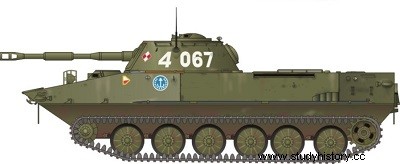
Type :amphibious light tank.
Crew :3 men.
Armament :a 76.2 mm gun; a coaxial 7.62 mm machine gun.
Armour :
maximum 14mm.
Dimensions:
length (barrel at 12 o'clock) :7.62 m;
length (hull): 6.91 m;
width: 3.14m;
height :2.19m.
Weight in combat order: 14 t.
Ground pressure: 0.48 kg/cm2.
Specific power :17.3 ch/t.
Performance:
road speed: 44 km/h;
speed on water: 10 km/h;
range: 260 km;
vertical obstacle: 1.10m;
straight cut :2.80 m;
slope :60%.
Service time: introduced in 1952. Used by Afghanistan, East Germany Angola, Bulgaria, China, Congo, North Korea, Cuba Egypt, Finland, Hungary, India, Indonesia, Iraq, Israel, Laos, Pakistan, Poland, Syria, Czechoslovakia, Soviet Union, Yugoslavia. Production ended in the early 1960s.
The Russians used amphibious tanks from the early 1920s. The PT-76 (Plavaushiy Tank) is based on the Penguin all-terrain vehicle. Since its introduction into the Red Army in 1952 it has been exported to
numerous countries and has fought in Africa, the Middle East and the Far East.
Its hull is an all wrought steel assembly.
The driver is at the front; the commander and the gunner are in the turret. Engine and transmission are at the rear.
The PT-76 is armed with a 76.2 mm gun, offering a range of fire from +30° to -40.
A 7.62 mm SGMT machine gun is twinned with it.
The ammunition load is 40 76.2 mm shells and 1,000 cartridges of 7 .62mm.
The PT-76 is distinguished above all by its amphibious character. It is propelled on the water by two hydro-reactors located on either side of the hull, with an exit at the rear of it. Prior to submersion, an anti-wave blade stands at the front of the hull and the driver's central episcope rises to allow him to see over the anti-wave blade.
The PT-76 was built in large quantities, and its basic chassis was used for a whole range of armored vehicles, including the BTR-50 personnel carrier, the ASU-85 airborne anti-tank gun, the ZSU-23 self-propelled anti-aircraft gun -4, the SA-6 “Gainful” anti-aircraft missile system, the BMP-1 motorized infantry vehicle, the “Frog” 2, 3, 4 and 5 tactical missile systems, the GSP amphibious carrier, the SP self-propelled gun -74 122mm and the GTT vehicle, to name a few.
A modified version, built in China as the Type 60, received the same hull as the PT-76 but had a new turret armed with an 85 mm cannon and a coaxial 7.62 mm machine gun, as well than a roof-mounted 12.7 mm anti-aircraft machine gun
Although over 20 years old, the PT-76 can still prove very effective as a reconnaissance vehicle. It is assumed that its successor in the Soviet army will be the new light fire support tank BMD.
